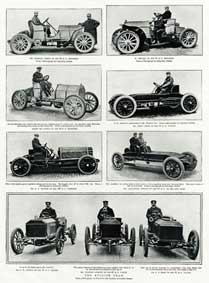
Buick is a division of the American automobile manufacturer General Motors (GM). Started by automotive pioneer David Dunbar Buick, it was among the first American marques of automobiles, and was the company that established General Motors in 1908. Before the establishment of General Motors, GM founder William C. Durant had served as Buick's general manager and major investor.

The Cadillac Motor Car Division is a division of the American automobile manufacturer General Motors Company (GM) that designs and builds luxury vehicles. Its major markets are the United States, Canada, and China. Cadillac models are distributed in 34 additional markets worldwide. Cadillac automobiles are at the top of the luxury field within the United States. In 2019, Cadillac sold 390,458 vehicles worldwide, a record for the brand.

D. Napier & Son Limited was a British engineering company best known for its luxury motor cars in the Edwardian era and for its aero engines throughout the early to mid-20th century.

American Motors Corporation was an American automobile manufacturing company formed by the merger of Nash-Kelvinator Corporation and Hudson Motor Car Company on May 1, 1954. At the time, it was the largest corporate merger in U.S. history.

Rambler is an automobile brand name that was first used by the Thomas B. Jeffery Company between 1900 and 1914.

Maxwell was a brand of automobiles manufactured in the United States of America from about 1904 to 1925. The present-day successor to the Maxwell company is Fiat Chrysler Automobiles.
The Locomobile Company of America was a pioneering American automobile manufacturer founded in 1899, and known for its dedication to precision before the assembly-line era. It was one of the earliest car manufacturers in the advent of the automobile age. For the first two years after its founding, the company was located in Watertown, Massachusetts. Production was transferred to Bridgeport, Connecticut, in 1900, where it remained until the company's demise in 1929. The company manufactured affordable, small steam cars until 1903, when production switched entirely to internal combustion-powered luxury automobiles. Locomobile was taken over in 1922 by Durant Motors and eventually went out of business in 1929. All cars ever produced by the original company were always sold under the brand name Locomobile.

The Hudson Motor Car Company made Hudson and other brand automobiles in Detroit, Michigan, U.S., from 1909 to 1954. In 1954, Hudson merged with Nash-Kelvinator to form American Motors Corporation (AMC). The Hudson name was continued through the 1957 model year, after which it was discontinued.

As one of three Gordon Bennett Cups established by James Gordon Bennett, Jr., millionaire owner of the New York Herald, the automobile racing award was first given in 1900 in France.

Daewoo Motors was a South Korean automotive company established in 1937 as "National Motors". The company changed its name several times until 1983 when it became "Daewoo Motors". After running into financial difficulties, it sold most of its assets in 2001 to General Motors, becoming a subsidiary of the American company and in 2011, the name "Daewoo" was definitively removed and the company renamed to GM Korea.

The Ford Piquette Avenue Plant is a former factory located within the Milwaukee Junction area of Detroit, Michigan, in the United States. Built in 1904, it was the second center of automobile production for the Ford Motor Company, after the Ford Mack Avenue Plant. At the Piquette Avenue Plant, the company created and first produced the Ford Model T, the car credited with initiating the mass use of automobiles in the United States. Prior to the Model T, several other car models were assembled at the factory. Early experiments using a moving assembly line to make cars were also conducted there. It was also the first factory where more than 100 cars were assembled in one day. While it was headquartered at the Piquette Avenue Plant, Ford Motor Company became the biggest U.S.-based automaker, and it would remain so until the mid-1920s. The factory was used by the company until 1910, when its car production activity was relocated to the new, bigger Highland Park Ford Plant.

The Kaiser-Frazer Corporation was the result of a partnership between automobile executive Joseph W. Frazer and industrialist Henry J. Kaiser. In 1947, the company acquired the automotive assets of Graham-Paige, of which Frazer had become president near the end of World War II. Kaiser-Frazer was the only new US automaker to achieve success after World War II, if only for a few years. When Frazer left in 1951, the company renamed itself the Kaiser Motors Corporation and continued until 1955.

Stevens-Duryea was an American manufacturer of automobiles in Chicopee Falls, Massachusetts, between 1901 and 1915 and from 1919 to 1927.

Hudson Hornet is a full-sized automobile that was manufactured by Hudson Motor Car Company of Detroit, Michigan from 1951 until 1954, when Nash-Kelvinator and Hudson merged to form American Motors Corporation (AMC). Hudson automobiles continued to be marketed under the Hudson brand name through the 1957 model year.

Australian Motor Industries (AMI) was an automobile assembly firm that was significant in the early history of the automotive industry in Australia.

Marquette was a brand used on several different automobiles, most recently on Buick's companion make.
This article provides an overview of the automotive industry in countries around the world.

The automotive industry in South Korea is the seventh-largest in the world as measured by automobile unit production and also the seventh-largest by automobile export volume.
Serbia's automotive industry is one of the most important industrial sectors and makes about 15% of industrial output of the country and 18% of all exports.
Bulgaria's production strongly depended on auto imports from the Soviet block earlier and currently depends on other European and Asian countries. Presently, Bulgaria introduced its own domestic supercar company, SIN Cars.


















